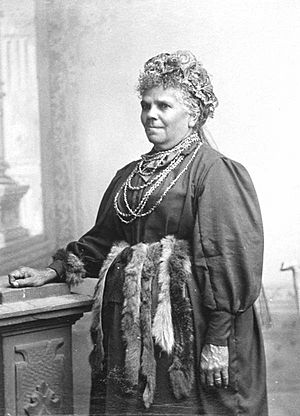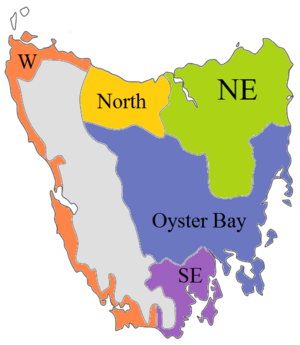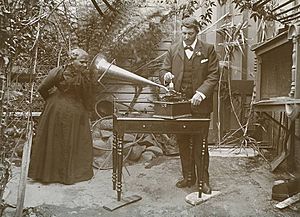Tasmanian languages facts for kids
Quick facts for kids Tasmanian |
|
|---|---|
| Ethnicity: | Aboriginal Tasmanians |
| Geographic distribution: |
Originally, throughout Tasmania; after the Black War, around the Bass Strait; now, presumably, only, in the Flinders Island and other parts of northeastern Tasmania |
| Linguistic classification: | at least three language families: Northeastern Oyster Bay – Southeastern Northern–Western? |
| Subdivisions: |
—
|
 Fanny Cochrane Smith, last speaker of the Flinders Islands Lingua franca, a Tasmanian Aboriginal language.
|
|
 Approximate ethnic divisions in pre-European Tasmania
|
|
The Tasmanian languages were the special languages spoken by the Aboriginal Tasmanians, the first people of the island of Tasmania. These languages were used for talking every day until the 1830s. The very last person who spoke one of these languages, Fanny Cochrane Smith, lived until 1905.
Contents
Studying Tasmanian Languages
Scientists have learned about Tasmanian languages from about 36 lists of words. The best lists were made by Joseph Milligan and George Augustus Robinson. These lists show that the people writing them didn't always understand the sounds of the languages very well.
In 1976, Brian Plomley collected all the words he could find. Later, in 1981, Terry Crowley and Robert M. W. Dixon wrote about the sounds and grammar they knew. In 2012, Claire Bowern looked at 35 different word lists. She tried to group them into language families.
Fanny Cochrane Smith made the only sound recordings of a Tasmanian language. She recorded Aboriginal songs on wax cylinders. These recordings are very old and hard to hear. In 1972, her granddaughters still remembered some words and a song. Even with these recordings, it's hard to learn much about the grammar.
Today, Tasmanian people are working to bring back their lost languages. One big project is called Palawa kani.
Connecting to Other Languages
We don't know much about these languages, and it's hard to prove if they are related to other languages. It seems there were several language families on Tasmania. This makes sense because people lived on the island for a very long time.
In the 1970s, Joseph Greenberg suggested a huge language group called "Indo-Pacific." This group included Tasmanian, Andamanese, and Papuan languages. However, most language experts today do not agree with this idea.
Tasmanian Language Families
Based on the word lists, there might have been anywhere from 5 to 16 languages in Tasmania. These languages might have belonged to about four different language families. Old records show that people from different groups couldn't understand each other. They needed a common language, or lingua franca, when they were moved to Flinders Island.
J.B. Walker visited Flinders Island in 1832 and 1834. He reported that Robert Clark, a teacher, said:
On his arrival at the Flinders' Settlement in 1834, eight or ten different languages or dialects were spoken amongst the 200 natives then at the establishment, and that the blacks were 'instructing each other to speak their respective tongues'.
Later, at the settlement in Oyster Cove, people said similar things:
The Aboriginal dialects made it difficult for the members of one family to understand that of another; "now however they all seem to have merged into one"
In 1952, Johannes Schmidt looked at the word lists. He thought there were five main languages:
- Eastern Tasmanian languages
- North-East
- East: East Central (Oyster Bay), South-East
- Western Tasmanian languages
- North Coast
- West Coast
The Eastern languages seem to share many words. They also use a special word part, na, at the end of nouns. The Western languages use leā instead of na.
Languages by Dixon & Crowley (1981)
In 1981, Dixon and Crowley studied the language information. They looked at 13 local language types. They believed there were 6 to 8 languages. They couldn't decide on two other types from the west coast because there wasn't enough information.
Here are some of the languages they found, starting from the northwest:
- North-western (T3) and Robbins Island (T11*)
* These were probably two forms of the same language. Circular Head might have been another form.
- Northern (T1)
* This was probably a separate language.
- Port Sorell (T13*)
* It's "unlikely" this language was closely related to any other Tasmanian language.
- Piper River (T14*), Cape Portland (T9*), and Ben Lomond (T7)
* These seem to be connected. They might have been forms of one language.
- North Midlands (T4)
* This "must" have been a different language.
- Oyster Bay (T2), Big River (T8*), and Little Swanport (T15*)
* Oyster Bay and Big River shared many words and were likely forms of the same language. Little Swanport might have been too.
- South-eastern (T5)
* This seemed to be a different language from Oyster Bay / Big River.
The two western types were South-western (T10*) and Macquarie Harbour (T6).
Languages by Bowern (2012)
It's hard to understand Tasmanian language information because some word lists mix words from different places. Also, for some lists, we don't know where the words came from. In 2012, Claire Bowern used special computer methods to sort out the information. She found 12 different Tasmanian language types. These types are probably distinct languages.
They fall into five groups:
- Western Tasmanian (2–3 languages): Northwestern and Southwestern areas.
- Northern Tasmanian (2 languages): Northern coast.
- Northeastern Tasmanian (3 languages): Northeastern, Ben Lomond, and North Midlands areas.
- Eastern Tasmanian (5 languages)
- Oyster Bay (2 languages): Oyster Bay and Big River valley.
- Bruny (Southeastern Tasmanian) (3 languages): Bruny Island.
Only 24 words out of 3,412 are found in all five groups. Most of these words are for new things, like guns or cattle. Or they are cultural words that could have been borrowed. This means there isn't strong proof that all Tasmanian languages came from one single language family.
There is a small chance that the northern and western language groups are distantly related. One promising word found in all regions is *wii, meaning 'wood' or 'tree'.
Flinders Island Lingua Franca
| Flinders Island lingua franca | |
|---|---|
| Region | Flinders Island, Tasmania |
| Ethnicity | Tasmanian |
| Extinct | 1905, with the death of Fanny Cochrane Smith |
| Language family |
koine, creole, pidgin, or a mixed language, based on the Eastern and Northeastern Tasmanian languages
|

Fanny Cochrane Smith, last speaker of the Flinders Island lingua franca
|
|
The lingua franca (common language) used on Flinders Island helped different Aboriginal groups talk to each other. We don't know if it was a koiné language (a mix of dialects), a creole language (a new language from a mix), a pidgin (a simplified language), or a mixed language. However, most of its words came from the Eastern and Northeastern languages. This is because people from those areas were the majority in the settlements.
Bass Strait Pidgin
| Bass Strait Pidgin | |
|---|---|
| Region | Flinders Island and, more generally, around the Bass Strait, Tasmania |
| Extinct | mostly, unattested (perhaps, 19th century) |
| Language family |
English Creole, with elements, mainly, of the Flinders Island Lingua franca. Also, contained words from the New Holland tribes, as well as, negrito words.
|
The Bass Strait Pidgin was a language mostly made of English words. It also had words from Tasmanian languages. These Tasmanian words were brought by Aboriginal women who lived with sealers around the Bass Strait.
Palawa Kani
Palawa kani is a new language being created today. It uses words that have survived from different Tasmanian Aboriginal languages.
Sounds of Tasmanian Languages
It's hard to be sure about the exact sounds of these languages. This is because the old records weren't very good at writing down sounds.
Tasmanian languages were different from most languages on mainland Australia. They had words that started with 'l' or 'r'. They also had consonant clusters, like 'br' and 'gr'. However, some languages in Victoria, across the Bass Strait, also allowed words to start with 'l'. The Gunai language in Gippsland, closest to Tasmania, also had words starting with 'r' and the clusters 'br' and 'gr'.
Grammar Basics
Here are some simple grammar rules, mostly from East-central Tasmanian.
- Nouns
There's no clear sign of words changing for plural (more than one) or for gender (like male/female). A special word part might have shown the end of a noun phrase.
| Eastern Tas. | Western Tas. | |
|---|---|---|
| woman | lowa-na | nowa-leā |
| hand | rī-na | ri-leā |
| kangaroo | tara-na | tara-leā |
To show who something belonged to, the owner's noun would drop its special word part:
- wurrawa lowa-na means 'the wife of the deceased' (the wife of the person who died).
- Postpositions
These are like prepositions, but they come after the noun. Some examples are le/li ('behind'), ra ('without'), and to/ta (showing a change in direction). There's also a suffix -re that can be added to words to make them adverbs, like in lene-re ('backwards').
- lunamea ta means 'to my house'.
- nee-to means 'to you'.
- Adjectives
Adjectives (words that describe nouns) come after the noun. Some end in -ne (like pāwine for 'small') or -ak (like mawbak for 'black' or tunak for 'cold').
- Pronouns
We only know the singular personal pronouns (words like 'I', 'you', 'he/she'):
- mī-na means 'I'
- nī-na means 'you'
- nara means 's/he'
These can also form possessive suffixes, like loa-mi meaning 'my woman'. Pronouns might also be part of the verb, like tiena-mia-pe meaning 'give me!'.
Demonstrative pronouns (words like 'this' or 'that') are wa/we ('this') and ni/ne ('that').
- Riena narra wa means 'this is my hand'.
- Numbers
Only two numbers are known:
- marra(wa) means 'one'
- pʲa(wa) means 'two'
- Verbs
The word noia means 'not' or 'no'.
- noia meahteang meena neeto linah means 'I won't give you any water'.
- (not give I to-you water)
In Southeast Tasmanian, verbs sometimes had suffixes like -gara/-gera and -gana/-gena. We don't know exactly what they meant.
- nunug(e)ra 'to wash'
- tiagarra 'to keep'
- nugara 'to drink'
- longana 'to sleep'
- poenghana 'to laugh'
- winganah 'to touch'
Basic Words
Here are some common words:
- nanga 'father'
- poa 'mother' (Northeast)
- pögöli-na 'sun'
- wīta 'moon'
- romtö-na 'star'
- pö ön'e-na 'bird'
- wī-na 'tree'
- poime-na 'mountain'
- waltomo-na 'river' (Northeast)
- nani 'stone'
It's hard to study these old records because the words for the same thing can look very different. For example, here are some ways "two" was written down:
| Region | Transcription | Possible pronunciation |
|---|---|---|
| South- eastern |
pooalih | [puwali] |
| bõw.lȳ | [pawuli] | |
| boula (Fr) | [pula] | |
| boulla (Fr) | [pula] | |
| bura | [pura] | |
| bourai (Fr) | [pure] | |
| cal.a.ba.wa | [kalapawa] | |
| North- eastern |
calabawa | [kalapawa] |
| kar.te.pew.er | [katapiwa] | |
| kateboueve (Fr) | [katapuwe(?)] | |
| narn.ne.meen.er | [nanamina] | |
| nar.ner.pee | [nanapi] | |
| par.le.the.meen.er | [palatamina] | |
| pay'ãnĕrbĕrwãr | [peyanapawa] | |
| North- western |
may | [me] |
| nue.won.ner | [nyuwana] | |
| neu.on.ne | [nyuwana] | |
| py.at.er.lare | [payatale] | |
| pie.nare.re.pare | [paynerape] | |
| by.ar.ty | [payatay] | |
| Oyster Bay | py.wer | [paywa] |
| pye.er.wer | [payawa] | |
| pye.er.wer | [payawa] | |
| pia-wah | [payawa] |
Even if some differences are due to word endings, there are clearly several different words for "two." It's hard to say exactly how many or what they sounded like.
Images for kids
See also
 In Spanish: Lenguas de Tasmania para niños
In Spanish: Lenguas de Tasmania para niños





